-
Posts
14,343 -
Joined
-
Last visited
-
Days Won
25
Content Type
Profiles
Forums
Blogs
Gallery
Events
Store
Posts posted by Ed_Haynes
-
-
Fascinating!

Many thanks, Tang Si!
 0
0 -
W NIB 09 and W NIB 10 -- Sport Master
What seen to be earlier (W NIB 09) and later (W NIB 10) versions of the familiar Sport Master badge (W 04).
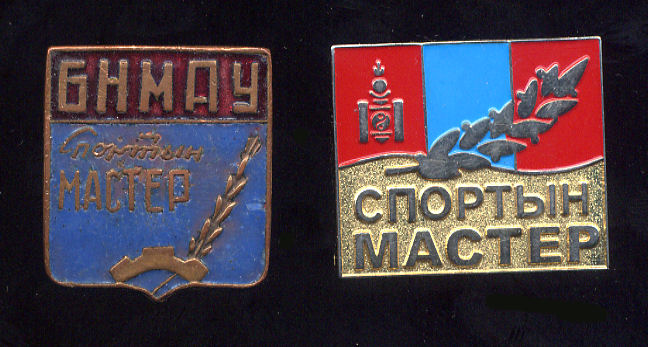

 0
0 -
W NIB 08 -- Mongolian Racing
This is an amazing badge, and I suspect it will not scan well. The image of the horse and rider is custom-carved from a dark green stone (jadeite of some sort?) and is highly three-dimensional. A tiny work of wearable art!
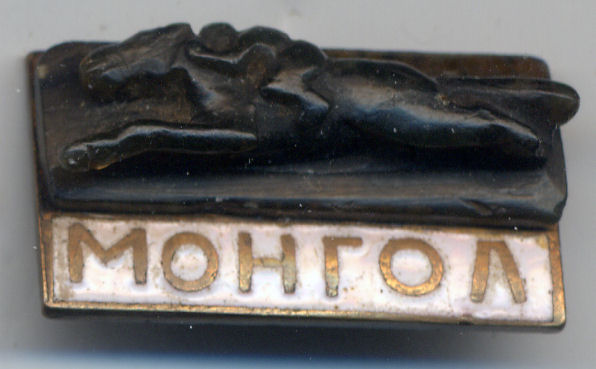

 0
0 -
T NIB 05 -- Mongolian Medicine
A tiny little 14 mm.
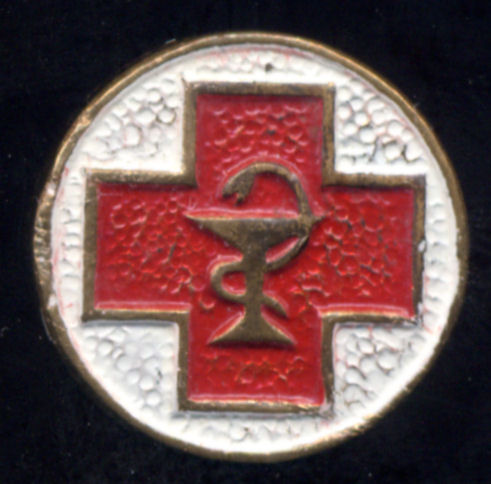

 0
0 -
S NIB 06 -- Mongolian Circus


 0
0 -
W NIB 07 -- 50 Years of Mongolian Sport


 0
0 -
W NIB 04 -- Spartakiad of the Mongolian Trade Union
W NIB 05 and W NIB 06 -- Spartakiad of the Mongolian Trade Union
Looks like this came in three classes?


 0
0 -
Right, Jim! And turmning those stones over is such fun.
 0
0 -
C NIB 06 -- Unit 805 of the Interior Armed Forces
How does this relate to C 49? What is "Unit 805"?
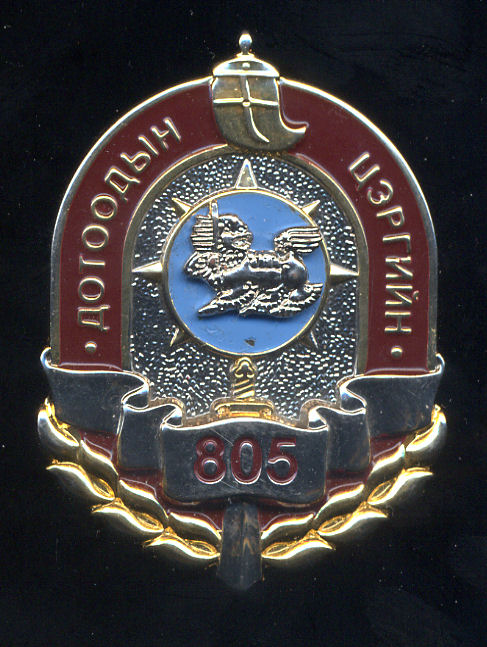

 0
0 -
U NIB 03 -- Mongolian Childrens' Palace


 0
0 -
V NIB 15 -- The Outstanding Young Worker of the 7th Canteen
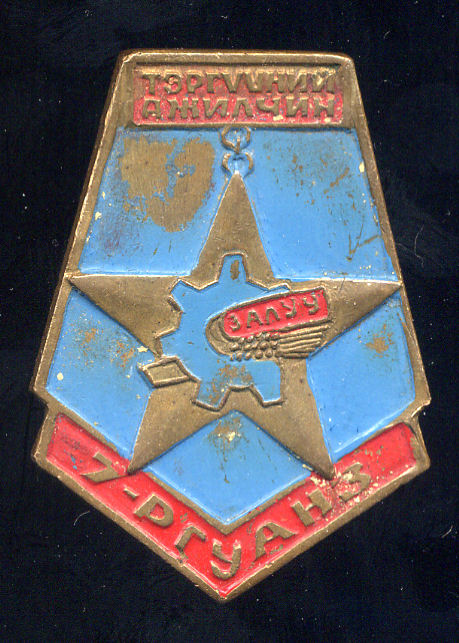

 0
0 -
V NIB 14 -- Young Inventor's Badge, 1988
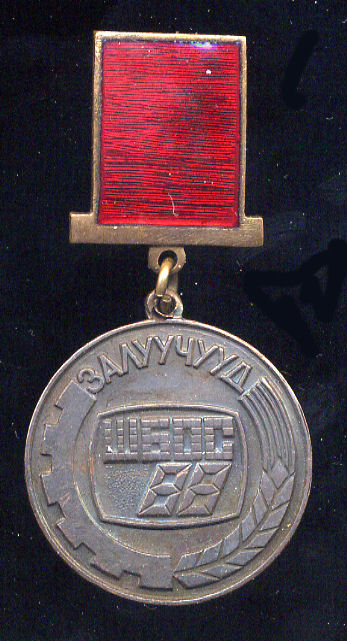

 0
0 -
E NIB 01 -- Common Control of the State Border
For the Mongolian-Chinese border revision and control commission of 2002-2004.
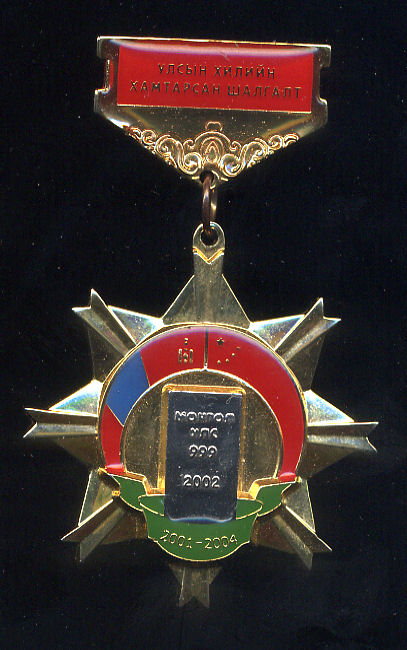

 0
0 -
F NIB 12 -- Outstanding Worker of the Customs Agency


 0
0 -
X NIB 06 -- 50 Years of the Mongolian Trade Union
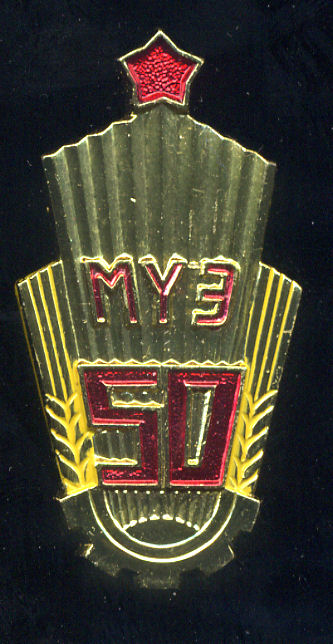

 0
0 -
Q NIB 03 -- Outstanding Worker of the Weather Forcasting Service
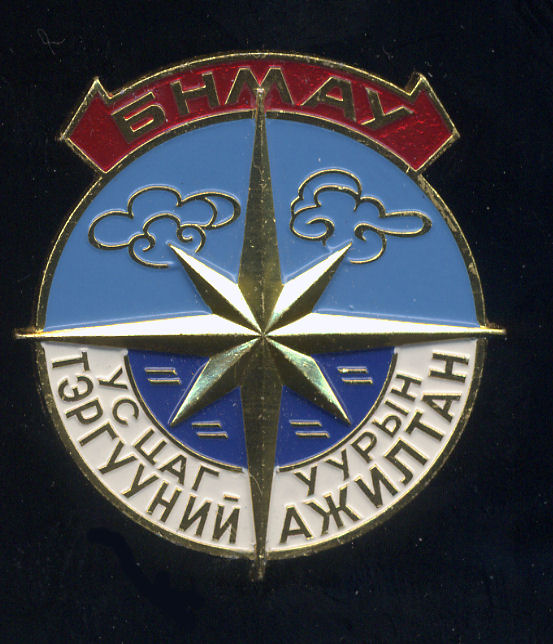

 0
0 -
Interesting question. But the problem is that we sit, here, many kilometers (most of us) and many years (all of us) away from the time and place and circumstances of the original decision. Until and unless someone takes the time and effort actually to look at the archival records and explore this question seriously, we'll just be wildly and irrelevantly guessing.
I guess that is OK if it is fun, but let us not confuse this fun with anything that tells us anything at all about phaleristic history.
0 -
Star is najma (نجمة) in Arabic. In the Cairo dialect dominant in Egypt, "j"s become "g"s, but the word is still feminine. So وسام النجمة العسكرية is wisaam al-nagma al-`askariyya.
Arabic transliteration isn't really well-standardized, though, given not just the dialect differences and lack of an agreed set of correspondences for letters (aa or A for the long "a", for example), but also the objectives: do you transliterate to facilitate spelling or pronounciation? If the latter, for example, an-nagma is preferable since the "l" of al- is lost before certain consonants.
Thanks, Dave, it is difficult. And 'tis far from "rocket science". I have tended to go with the English transliteration that the majority of relevant friends in-country have tended to prefer (when such is available). For Egypt, I have been guided by the major late (and lamented) manufacturer of ODM in Cairo. I do this even if what I habitually use is linguisitically deviant. And I don't mind corrections, differences, alternatives. Honestly, I'd prefer just to show the Arabic and be done with it. (How do you do it? I have lost out on all such efforts, producing just gibberish. Using Hindi is worse.)
0 -
Medal for the 25th Anniversary of the Ba'ath Party
For the 25th anniversary of the Ba'ath Party in Syria (1962-87?).
Obverse: A silver shield-shaped medal, 35 x 41 mm. A volcano-like structure, spouting flames, with a cog-wheel behind. Above a roughly-painted depiction of the Iraqi flag and, below, the dates "1962 / 1987". Suspended from a ring.
Reverse: An upright rifle, spear, spade, and crescent, with a legend on either side. Above, another legend. Above all, a sunburst design with a depiction of the Ba'ath Party flag in the upper center.
Ribbon: 30 mm, white with two orange stripes toward each edge: 1 mm white, 3? mm orange, 2 mm white, 3? mm orange, 9 mm white, 3? mm orange, 2 mm white, 3? mm orange, 1 mm white,

 1
1 -
Wisam al-Tadrib / Medal of Training
Awarded to officers in command of a unit of at least company size which has achieved high ratings in training exercises over a period of at least one year. During this time, the recipient must have served actively with his unit and displayed a documented high standard of conduct and behavior. Subsequent awards are indicated by the addition of a bronze oak leaf to the ribbon. This medal was also awarded to Saudi Arabian troops. This medal has also been incorrectly associated with the Syrian Golan Heights campaign of 1973-74.
Obverse: A 42-mm five-pointed gilt star with a circular center bearing a green-enameled helmet, crossed anchor and rifle, with horizontal wings; through all, there is an upright torch with red-enameled flames. Above and below, Arabic inscriptions; "To sweat in peace saves pain in war" above and "Wissam al-Tadrib" or "Medal of Training" below. Suspended by a ring.
Reverse: Plain.
Ribbon: 31 mm, divided into three equal stripes (left to right) of blue, bluish white, and medium green. A bronze oak leaf is worn on the ribbon to indicate a second award. This ribbon has been sometimes incorrectly depicted as equal stripes of black, gray, and black.

 1
1 -
Order of the Wounded
Awarded to both military and civilian personnel who are wounded while performing services for the state. The medal may be awarded to non-Syrians, though it is not awarded posthumously. Under conditions of special bravery, the medal is usually presented personally by the commander-in-chief (the Syrian president), indicating the prominence with which this award is viewed. This award has also been referred to in English as the "War Casualty Medal".
Established: By Legislative Decree No. 165 of 4 July 1953.
Obverse: A 37 mm five-pointed bronze star with rays between the points. The center has a wreath surrounding a central enameled circle of green and concentric circles (reading outward) of black, white, and red enamel. There is an upright sword overlaying the whole star. Suspended by a ring.
Reverse: Plain.
Ribbon: 37 mm, green with a 6 mm yellow stripe toward each edge: 2 mm green, 6 mm yellow, 19 mm green, 6 mm yellow, 2 mm green.
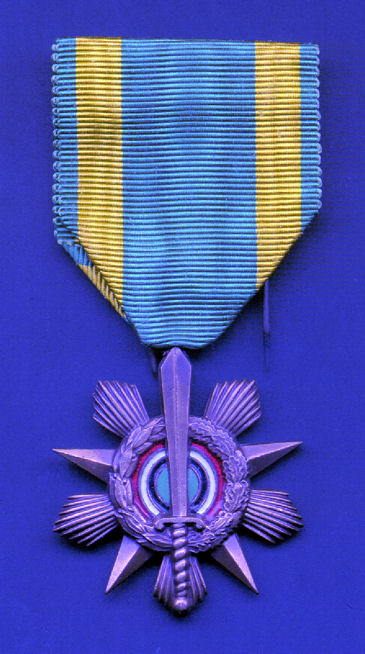
 1
1 -
Order of the Palestine Campaign
On 16 May 1948, one day after the united Arab declaration of war against Isarel, Syrian troops attacked across the Golan Heights. By 31 October, the Syrian war with Israel had ended unsuccessfully, as Syria had been forced back along most of their border with the Zionist state. Sporadic fighting continued until the armistice on 20 July 1949. Awarded for valor and service in the battles in Palestine in 1948. The medal may be awarded to foreigners and can be awarded posthumnously. There is some indication that award may have been extended beyond the initial period of service - for the 1948 war - and that it may have become a generalized award for service against Israel? This medal has also been referred to as the "Palestine Medal". The lack of Syrian success in the war, coupled with the massive number (over 100,000) of Palestinian refugees who moved into Syria, became one of the factors which would, over the following decades, encourage military intervention in the Syrian government.
Established: By Legislative Decree No. 13 of 18 December 1951 and amended by Legislative Decree No. 9 of ???.
Obverse: A 37 mm x 50 mm dark bronze, essentially circular medal if one ignores the upward extension, with a green-enameled laurel wreath above and below. In the center is a map of Palestine and the Jordan Valey. To the right the Arabic inscription "Palestine" and, to the left, the date "1948" (note the C.E. date). The medal is topped by crossed swords, and above that a dome-shaped depiction of a Christian church topped by a crescent. The actual ribbon suspension is by a rather crude loop attached on the upper reverse of the medal.
Reverse: Plain, except for suspension loop.
Ribbon: 38 mm, medium red with two black stripes. Red 7 mm, black 6 mm, red 12 mm, black 6 mm, red 7 mm. The ribbon has also been seen with red with a white stripe toward each edge. It is presentlky unknown what that signifies.
Awards: Syrian forces number around 8000 troops, in two infantry brigades, a mechanized battalion, and a small air force.
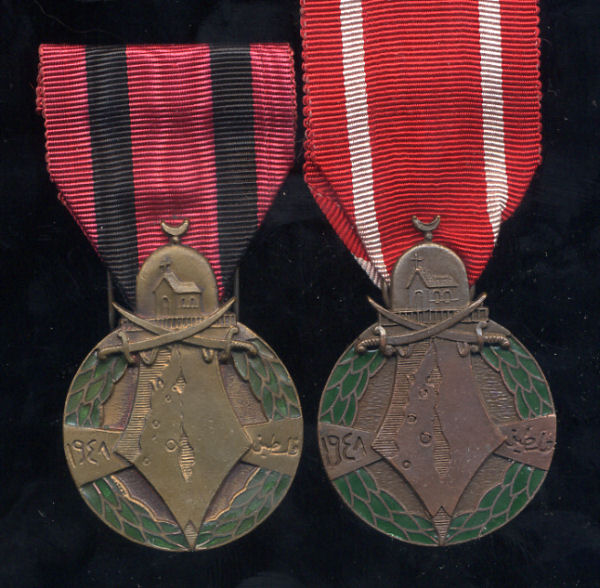
 1
1 -
Order of Civil Merit
Awarded for service to the state and to wider Arab causes. In normal classes, a recipient begins in the lowest class and, over time, works their way un through the order by successive promotion, often after specified period of service in lower ranks of the award. The order may be presented posthumously. This order represents a revision and modification of the earlier, French-created Honor Medal of Syrian Merit. On occasion, this order has been referred to as the "Syrian Merit Medal". This award is also known, quite unofficially, as the "Order of the Arrows". The redesign of the earlier medal served to remove the overall design similiarity of the previous award to a "Star of David" by reducing the number of points of the star from six to five and resulted in a complete redesign of the reverse.
Established: By Legislative Decree No. 153 of 25 June 1953.
Obverse: A gilt circular, patterned plaque, with a gilt five-pointed, white-enameled star. The center enameled green in an open pentagonal shape. The overall impression is of five white arrowheads pointed outwards from a green center. Suspended by a ring.
Reverse: Gilt with brown-enameled elaborate Arabic inscription.
Ribbon: White with a green center stripe.
first class - Excellent Class - sash (worn over ??? shoulder), sash badge and breast star (worn on ??? breast)
second class - also termed First Class - silver-gilt and enamel neck badge (36-mm ribbon) and breast star (worn on ??? breast)
third class - also termed Second Class - bronze-gilt and enamel neck badge (36-mm ribbon) (shown below)
fourth class / officer - also termed Third Class - bronze-gilt and enamel breast badge, rosette
decoration / knight - also termed Fourth Class - bronze enameled breast badge, 44 mm

 1
1 -
By request (
 ), I move on to Syria.
), I move on to Syria.Sources:
http://faculty.winthrop.edu/haynese/medals/Syria/syria.html
http://www.omsa.org/photopost/showgallery.php?cat=553
http://www.medals.org.uk/syria/syria.htm
http://www.netdialogue.com/yy/Asia/Syria/Syria.htm
http://www.coleccionesmilitares.com/cintas/cintasas.htm#s (click on his Syrian link)
0




spanish civil war medal
in Spain
Posted
Thanks, Eitze! One more incredibly rare Scandaluzzi book that I wish I owned!!